Cairo and Giza got beautiful architectural jewels that are hidden in the rough that we are losing them fast those days.
Those hidden jewels are the residential palaces, villas and residential buildings with private gardens in side streets that nobody pays attention except when they are demolished and replaced by ugly cement buildings or to be precise cement blocks.
In Giza’s old Dokki, there are many hidden villas and palaces with a very unique architectural style that stand in a race of time.
Some of those palaces and buildings got very interesting stories about their owners who were once famous people and played an important role in the modern history of Egypt.
One of those places is the magnificent Palace of late physician Dr. Salem “Bey” El-Hendawy in the heart of Dokki, Giza governorate.
All that I know about that palace that was built in 1932 and some say that it was a gift from King Fouad I to the late famous Dr. El-Hendawy for his services. Already the palace is located in Abdullah El-Kateb street, which was used to be named El-Hendawy street after the late doctor.
The original name is still kept in Google Maps in some kind of irony.
Historically the area where the palace is located was packed with palaces owned by members of Mohamed Ali Royal Family as well the Pashas but that palace truly stands out with its distinguished Neo-Islamic style.
I do not know its architect was but I think it could be legendary architect Mostafa Pasha Fahmy because he was fond of that Neo-Islamic style.
After more than 80 years, the daughters of Dr. El-Hendawy put it up for sale with demolishment license for a price tag equal to LE 83 Million in April. Listing it in OLX “Egypt’s equivalent to eBay” was enough to catch the media’s attention in April.
Despite looking monumental, the ministry of antiquities stated in April that the palace was not regarded or registered as a monument officially.
Born in Mounfia’s rural Sinjilf village, Dr. Salem El-Handawy was graduated from Kasr Al-Ainy School of Medicine in 1910 as an ophthalmologist where he worked in Al-Abbasy hospital.
He was appointed in 1918 as the general manager of Ophthalmology Hospital at the Bimaristan of Qalawun “the hospital was not demolished in 1910, it became an Ophthalmology hospital only” in Islamic Cairo, Egypt’s oldest working hospital since the 13th century.
In nutshell in 1925, Egypt had sent as usual its “Al-Mahmal parade” which had carried the Holy Kaaba’s Kiswah from Cairo to Mecca on the back of a camel in the protection of Egyptian armed military unit accompanied by a military musical band along with its official pilgrimage delegation.
According to historical accounts , the Egyptian military band had that usual cheerful entrance when it entered Mecca “ I swore by God I can’t imagine this so easily now” which the locals in the Holy City liked and welcomed but one of the armed zealous Wahabi groups from King Abdel Aziz Al-Saud’s allies stationed there did not like or want music.
In an act of foolishness, that group attacked the military band and in return, the armed Egyptian military unit opened their fires to protect the Egyptian parade and it turned in to a diplomatic fiasco that the relations were severed and cut for a while.
Egypt used to send the Kiswah from middle ages till Nasser stopped because of his fights with Saudi
Arabia in the 1950s and 1960s. Its procession was a big cheerful event the King used to attend along Egyptians.
A couple of years later, Dr. El-Hendawy’s fame reached Saudi Arabia as an excellent ophthalmologist that King Abdel Aziz Al-Saud requested that he would come to the kingdom to treat his son and crown prince then Saud but our doctor apologized because it was hard for him to treat his patient in the hot weather of Saudi Arabia. “It seems that it was during summer with no air conditioner what so ever”.
In a smart move, the Egyptian government along with King Fouad I officially invited Crown Prince Saud to Cairo to receive treatment and King Abdel Aziz accepted that invitation considering it as a new page between Egypt and the newly founded Kingdom.
Interestingly, I found a photo for Dr. El-Hendawy with King Abdel Aziz Al-Saud along with another Egyptian physician.
Personally, I wish that that palace will turn in to some sort of cultural venue serving Dokki and Agouza before it is too late.
Those hidden jewels are the residential palaces, villas and residential buildings with private gardens in side streets that nobody pays attention except when they are demolished and replaced by ugly cement buildings or to be precise cement blocks.
In Giza’s old Dokki, there are many hidden villas and palaces with a very unique architectural style that stand in a race of time.
Some of those palaces and buildings got very interesting stories about their owners who were once famous people and played an important role in the modern history of Egypt.
One of those places is the magnificent Palace of late physician Dr. Salem “Bey” El-Hendawy in the heart of Dokki, Giza governorate.
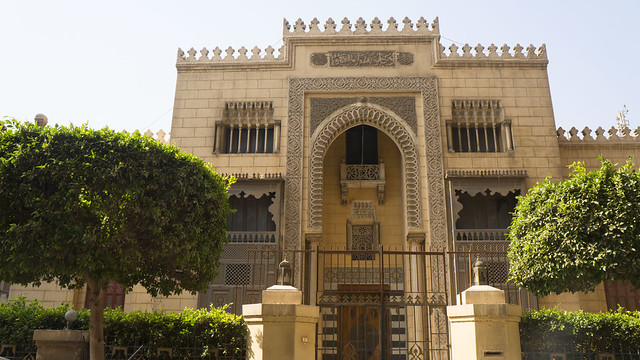 |
| The Salem El-Hendawy palace's beautiful entrance |
The original name is still kept in Google Maps in some kind of irony.
Historically the area where the palace is located was packed with palaces owned by members of Mohamed Ali Royal Family as well the Pashas but that palace truly stands out with its distinguished Neo-Islamic style.
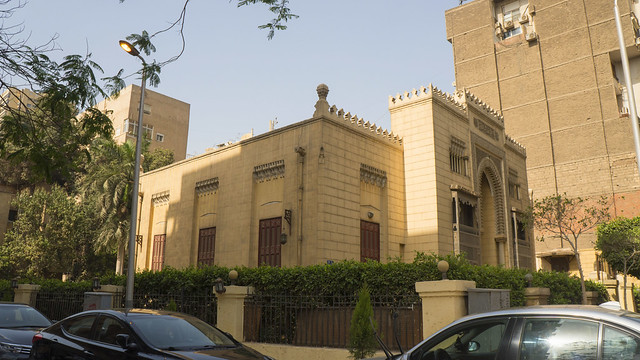 |
| The Palace and its garden occupies 1200 meter square |
I do not know its architect was but I think it could be legendary architect Mostafa Pasha Fahmy because he was fond of that Neo-Islamic style.
After more than 80 years, the daughters of Dr. El-Hendawy put it up for sale with demolishment license for a price tag equal to LE 83 Million in April. Listing it in OLX “Egypt’s equivalent to eBay” was enough to catch the media’s attention in April.
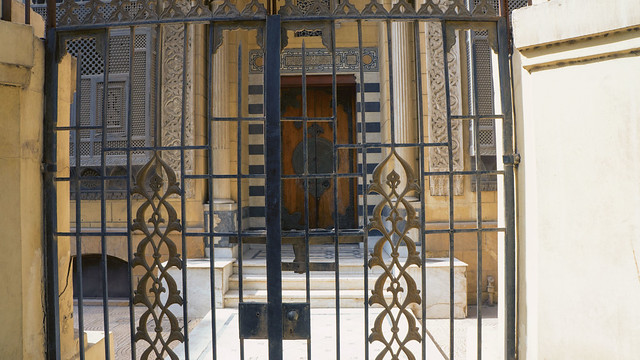 |
| It is abandoned now as Dr. El-Hendawy's daughters want to sell it |
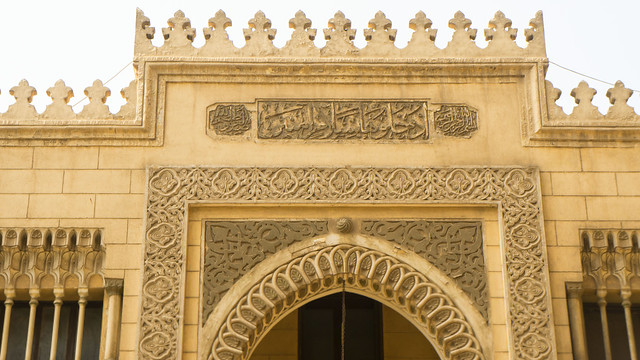 |
| "Enter ye here in peace and security" Quranic verse {Ch.15 - Al-Hijr Sura: Verse 45} decorating the entrance |
Born in Mounfia’s rural Sinjilf village, Dr. Salem El-Handawy was graduated from Kasr Al-Ainy School of Medicine in 1910 as an ophthalmologist where he worked in Al-Abbasy hospital.
He was appointed in 1918 as the general manager of Ophthalmology Hospital at the Bimaristan of Qalawun “the hospital was not demolished in 1910, it became an Ophthalmology hospital only” in Islamic Cairo, Egypt’s oldest working hospital since the 13th century.
 |
| A wooden Mashrabiya style window |
In nutshell in 1925, Egypt had sent as usual its “Al-Mahmal parade” which had carried the Holy Kaaba’s Kiswah from Cairo to Mecca on the back of a camel in the protection of Egyptian armed military unit accompanied by a military musical band along with its official pilgrimage delegation.
According to historical accounts , the Egyptian military band had that usual cheerful entrance when it entered Mecca “ I swore by God I can’t imagine this so easily now” which the locals in the Holy City liked and welcomed but one of the armed zealous Wahabi groups from King Abdel Aziz Al-Saud’s allies stationed there did not like or want music.
In an act of foolishness, that group attacked the military band and in return, the armed Egyptian military unit opened their fires to protect the Egyptian parade and it turned in to a diplomatic fiasco that the relations were severed and cut for a while.
Egypt used to send the Kiswah from middle ages till Nasser stopped because of his fights with Saudi
 |
| El-Hendawy on the right with King Abdel Aziz Al-Saud in a later visit to the Kingdom |
A couple of years later, Dr. El-Hendawy’s fame reached Saudi Arabia as an excellent ophthalmologist that King Abdel Aziz Al-Saud requested that he would come to the kingdom to treat his son and crown prince then Saud but our doctor apologized because it was hard for him to treat his patient in the hot weather of Saudi Arabia. “It seems that it was during summer with no air conditioner what so ever”.
In a smart move, the Egyptian government along with King Fouad I officially invited Crown Prince Saud to Cairo to receive treatment and King Abdel Aziz accepted that invitation considering it as a new page between Egypt and the newly founded Kingdom.
Interestingly, I found a photo for Dr. El-Hendawy with King Abdel Aziz Al-Saud along with another Egyptian physician.
Back to the palace, well I respect the wish of El-Hendawys to sell it because I know we got hard economic times in Egypt but at the same time I am praying that the palace will stand still for another 17 years so it can be monumental according to the law and won’t be demolished.
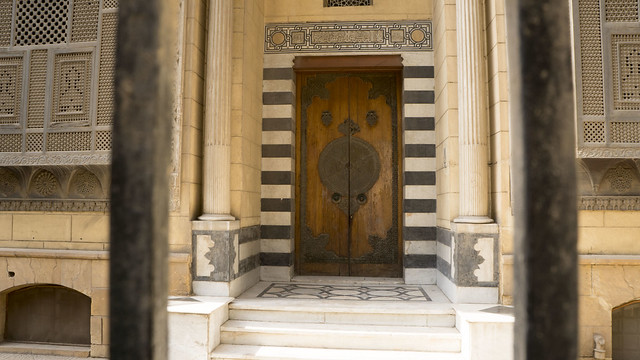 |
| The entrance with marble |
I began to notice Salem El-Hendawy Palace from a couple of years ago when I guess AMIDEAST Egypt rented it as an office in Dokki for some time.
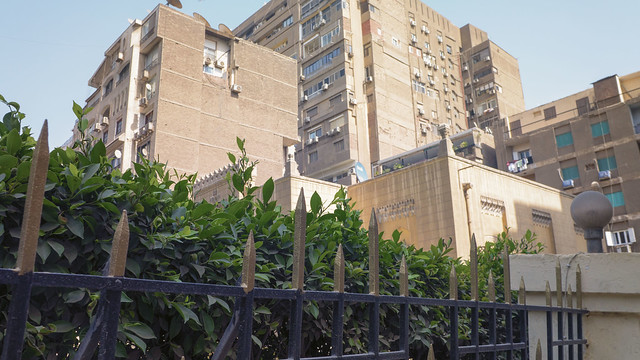 |
| The Palace is overshadowed by ugly modern cement blocks |
Personally, I wish that that palace will turn in to some sort of cultural venue serving Dokki and Agouza before it is too late.

No comments:
Post a Comment
Thank You for your comment
Please keep it civilized here, racist and hateful comments are not accepted
The Comments in this blog with exclusion of the blog's owner does not represent the views of the blog's owner.